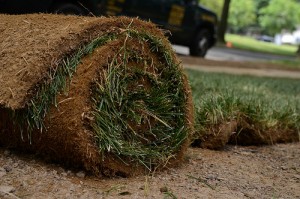Fall is a great time to take a good look at your grass and assess its condition. If wear and tear is minor, you may be able to just overseed. However, if it has taken a beating over the previous months, consider doing some lawn renovations and enhancements. This is a way to improve large sections of your yard without completely starting over.
You start by testing your soil to make sure there are not any underlying problems that would also affect the new seedlings. Dig down a few inches in several locations throughout the lawn and combine it into one sample. Send it off to a soil laboratory (like that available from the cooperative extension service) for analysis. They will tell you if any nutrients are lacking and can give recommendations on what to use.
Next you need rid of the existing lawn in the areas that you want to improve. You need it to be completely bare, so spray it with an herbicide that kills both grass and weeds. You don’t want a kind that will be long lasting, since that would just affect any grass seeds you sow. You also want to make sure that you do not get any on the lawn that you do want to keep.
Assess the condition of the thatch layer. You may likely need to remove some of it, as this is a common cause of problems in your yard. Loosen up the soil and apply any recommended fertilizers and amendments.
Once these steps are taking, you are ready to add the new grass. by the first part of fall lest early winter frosts cause damage. You want to do this Possible choices include seeds, sod and plugs. You can add the same type of grass or add another kind that works well for the planting site conditions. Keep it moist for the first few weeks to help nurture the plants and prevent them from drying out.
Have you renovated your lawn? How long did the process take?
Image by slgckgc under a Flickr Creative Commons Attribution License



